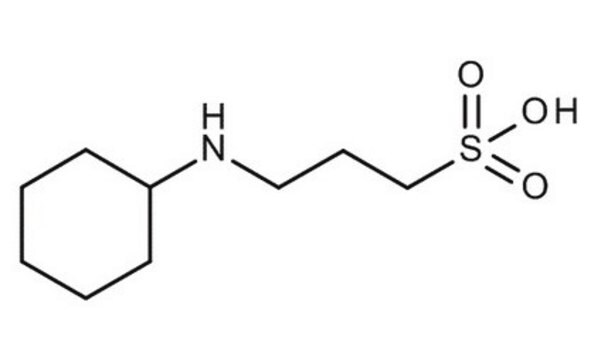Kluczowe dokumenty
C2278
CAPSO
≥99% anhydrous basis (titration)
Synonim(y):
3-(Cyclohexylamino)-2-hydroxy-1-propanesulfonic acid, CAPSO Free Acid
About This Item
Polecane produkty
Poziom jakości
Próba
≥99% anhydrous basis (titration)
Formularz
crystalline powder
pH
2.5-4.0
przydatny zakres pH
8.9-10.3
pKa (25°C)
9.6
rozpuszczalność
water: 0.111 g/mL, clear, colorless
Zastosowanie
diagnostic assay manufacturing
ciąg SMILES
OC(CNC1CCCCC1)CS(O)(=O)=O
InChI
1S/C9H19NO4S/c11-9(7-15(12,13)14)6-10-8-4-2-1-3-5-8/h8-11H,1-7H2,(H,12,13,14)
Klucz InChI
INEWUCPYEUEQTN-UHFFFAOYSA-N
Szukasz podobnych produktów? Odwiedź Przewodnik dotyczący porównywania produktów
Powiązane kategorie
Opis ogólny
Zastosowanie
- To maintain pH 9 during water leach test for the analysis of high-carbon coal fly ash-soil mixtures.
- Chemiluminescent in situ hybridization using soybean peroxidase-labeled peptide nucleic acid (PNA) probes. I
- Preparation of planar bilayer lipid membranes.
Kod klasy składowania
11 - Combustible Solids
Klasa zagrożenia wodnego (WGK)
WGK 3
Temperatura zapłonu (°F)
Not applicable
Temperatura zapłonu (°C)
Not applicable
Środki ochrony indywidualnej
Eyeshields, Gloves, type N95 (US)
Wybierz jedną z najnowszych wersji:
Masz już ten produkt?
Dokumenty związane z niedawno zakupionymi produktami zostały zamieszczone w Bibliotece dokumentów.
Klienci oglądali również te produkty
Nasz zespół naukowców ma doświadczenie we wszystkich obszarach badań, w tym w naukach przyrodniczych, materiałoznawstwie, syntezie chemicznej, chromatografii, analityce i wielu innych dziedzinach.
Skontaktuj się z zespołem ds. pomocy technicznej









